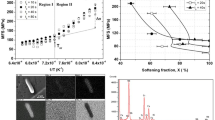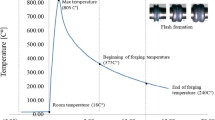Abstract
The link between dissipated energy in a cyclically loaded AISI 316L stainless steel and its microstructural changes is investigated. After a brief introduction to energy dissipation in materials, the experiments devised to investigate if different microstructures, resulting from different heat treatments, has a measurable effect on the dissipated energy are detailed. The data processing procedure and some preliminary results are described. Future work aimed at characterising the dissipative heat source in welds is presented.
Access provided by CONRICYT-eBooks. Download conference paper PDF
Similar content being viewed by others
Keywords
3.1 Introduction
Welding is an important joining technique which induces residual stresses in a component. The presence of residual stress in components can be detrimental to their service life as residual stress can interact with various degradation mechanisms like stress corrosion cracking, fatigue and fracture. At present residual stresses are mainly assessed using two categories of measurement techniques: destructive and non-destructive. The destructive (or semi-destructive) techniques such as the hole-drilling method gives accurate residual stress measurements but are not suitable to be used in residual stress measurement of safety critical components. Non-destructive techniques such as X-ray and neutron diffraction have limitations such as being costly and not portable. Therefore, there is scope for a full-field, non-destructive and portable technique like thermography to be applied in residual stress assessment. Researchers have attempted to assess residual stress using Thermoelastic Stress Analysis (TSA) [1, 2] but none of the proposed approaches have been successfully transformed into an industrial technique. Energy dissipation which results in the temperature rise in materials (also known as self-heating) is another effect that accompanies mechanical deformation of material. This phenomena has not yet been applied in residual stress assessment, though many studies have focused on using this as a marker of fatigue damage [3, 4]. It is well known that weld joints consist of at least three different regions with different microstructures: the base metal, the fusion zone, and the heat affected zone. In the context of assessing residual stress, one has to first estimate the intrinsic dissipation of these zones without residual stresses. The work in the present paper examines the effect of different microstructures, such as those developed during welding processes on the energy dissipation in AISI 316L stainless steel (EN1.4404), a material commonly used to produce nuclear power plant components. It is expected that these results will contribute to the understanding of the dissipative heat source around the weld for the purpose of residual stress measurement.
3.2 Energy Dissipation
Energy dissipation in metallic materials subjected to mechanical deformation is a result of the movement of dislocations, among other less important mechanisms. It has been shown that even cyclic loads below the macroscopic yield stress can lead to significant energy dissipation [5]. Dissipation manifests itself as a temperature rise in the material being loaded. However, this temperature rise is not intrinsic to the material behaviour as it’s affected by thermal exchanges between the specimen and its environment. Therefore, the heat source has to be calculated as this relates directly to the material behaviour. It can be calculated from the temperature by using the heat diffusion equation:
where ρ is the density, c is the specific heat capacity, θ is the temperature variation from the first temperature map, t is time, k is the thermal conductivity, τ is the time constant for linearised convective and radiative exchanges [6], H D is the dissipative heat source and H th is the thermoelastic heat source.
3.3 Experimental Work
A range of heat treatments were carried out on AISI 316L to produce different microstructures that replicate microstructures found in AISI 316L welds. Strip specimens of dimension 300 mm × 30 mm × 2 mm were uniformly heated at 1150 °C (annealing temperature of AISI 316L) for 2 min and then cooled by the following methods: cooled at room temperature, water quenched and furnace cooled at 100 °C h−1. Another set of identical specimens were tested in the as received condition and used as control specimens. Micrographs of the resulting microstructure in each case and their respective average grain sizes are shown in Fig. 3.1.
Micrograph of the specimens: (a) control (b) water quenched (c) cooled at room temperature (d) furnace cooled [7]
The specimens were subjected to uniaxial cyclic load of various stress amplitudes below and just about the yield stress, at a stress ratio, R σ of 0.1 using an Instron 8800 servo-hydraulic testing machine. The resulting temperature variations were recorded using a Cedip Silver 480M infrared detector. As the temperature variations expected is lower than the Noise Equivalent Temperature Difference (NETD) of the infrared detector, data processing methods developed by Maquin and Pierron [5] have been used as detailed in the section below. Due to limited detector sensitivity it is also important to reduce background radiation which is one of the main sources of noise. The necessary thermal insulation was provided in the form of a chamber (polystyrene covered with Aluminium foil) placed surrounding the specimen (see Fig. 3.2a). The entire path connecting the camera to the opening of the chamber was also protected using the same chamber material. Besides that, a reference specimen [5] made of the same material as the specimen was placed next to the specimen (see Fig. 3.2b). This ensures that the fluctuations in the environmental temperature can be taken into account.
3.4 Data Processing, Detection Threshold, and Preliminary Result
The data processing methods employed to improve the detection threshold include image subtraction, spatial averaging, filtering and smoothing. The first image (before the start of the cyclic loading) was subtracted from the subsequent images (see Fig. 3.3 step 1). The effect of thermal reflections were supressed through this operation. Spatial averaging (see Fig. 3.3 step 2) refers to the calculation of the mean value of all of the pixels contained in the region of interest (specimen and reference specimen) in a frame. The region of interest was averaged horizontally and then vertically. The spatial mean of the reference specimen temperature variation was subtracted from the spatial mean of the specimen temperature variation (see Fig. 3.3 step 3). The resulting overall temperature variation of the specimen consists of monotonic rise superimposed to a cyclic thermoelastic temperature variation. Extraction of the temperature rise from the overall temperature variation was done by implementing a notch filter. This was possible due to the fact that the thermoelastic temperature variation was known to be harmonic and occurs at the same frequency as the loading. The extracted temperature rise was not free from noise and therefore smoothing was performed. Smoothing replaces a data point with the average of the neighbouring data points. A suitable temporal smoothing window size was chosen based on the camera frame rate and loading frequency so as to maintain accuracy of the result (see Fig. 3.3 step 4). The smoothed temperature variation was then used to calculate the dissipative heat source.
The method employed in this work enables the determination of the dissipative heat source in the very first few cycles of fatigue loading. However, the heat source levels involved in this study is very low. As such, the detection threshold of the method or noise floor needs to be determined so that the results can be presented with known confidence level. In this study, the detection threshold or noise floor is the threshold above which the results have a confidence level of 95 %. It was determined by recording the data without applying the cyclic load. The dissipative heat source is not activated in this case and any temperature variation is likely to be noise caused by the detector or thermal exchanges with the surrounding. This process was repeated three times and the resulting data was subsequently processed with the same method as detailed above. The mean and the standard deviations of the resulting heat source was calculated using these three sets of data collected. The two standard deviation interval gives the detection threshold above which measurements are significant at a confidence level of 95 %. Since the standard deviation was shown to be constant in time, it was averaged to provide a single value. The heat source detection threshold was found to be 0.566 × 104 Wm−3. When divided by ρc (density and specific heat capacity), a detection threshold is obtained in terms of heating rate which corresponds here to 1.4 mK s−1. This implies that, in a period of one second, the combination of the thermographic measurement and data processing method has a noise equivalent to 1.4 mK. The red lines in Fig. 3.4 show the two standard deviation levels. As the noise heat source computed is random, positive and negative thresholds are shown. The heat source of the as received AISI 316L cyclically loaded at a stress ratio, R σ of 0.1 with a maximum stress, σ max of yield stress (250 MPa) is also shown in Fig. 3.4. The results are similar to the ones obtained by Connesson et al. in [8] where the initial peak was attributed to microplasticity due to irreversible movement of dislocations and the stabilised source was attributed to viscoelasticity due to reversible movement of dislocations.
3.5 Conclusion and Future Work
The current setup is adequate to measure the spatially averaged heat source generated by a macroscopically homogenous stress field. Future work involving the characterisation of the dissipative heat source of a weld will require spatial averaging on smaller areas within the weld, thus increasing the detection threshold. This was tested in [9] and proved to be feasible if heat sources are high enough. This may need loading at higher stress levels.
References
Wong, A., Dunn, S., Sparrow, J.: Residual stress measurement by means of the thermoelastic effect. Nature 332, 613–615 (1988)
Robinson, A.F., Dulieu-Barton, J.M., Quinn, S., Burguete, R.L.: The potential for assessing residual stress using thermoelastic stress analysis: a study of cold expanded holes. Exp. Mech. 53, 299–317 (2012)
Luong, M.P.: Fatigue limit evaluation of metals using an infrared thermographic technique. Mech. Mater. 28, 155–163 (1998)
Boulanger, T., Chrysochoos, A., Mabru, C., Galtier, A.: Calorimetric analysis of dissipative and thermoelastic effects associated with the fatigue behavior of steels. Int. J. Fatigue 26, 221–229 (2004)
Maquin, F., Pierron, F.: Heat dissipation measurements in low stress cyclic loading of metallic materials: From internal friction to micro-plasticity. Mech. Mater. 41, 928–942 (2009)
Louche, H., Chrysochoos, A.: Thermal and dissipative effects accompanying Lüders band propagation. Mater. Sci. Eng. A 307, 15–22 (2001)
Chevallier, E.: Private Communication, 2016
Connesson, N., Maquin, F., Pierron, F.: Dissipated energy measurements as a marker of microstructural evolution: 316L and DP600. Acta Mater. 59, 4100–4115 (2011)
Connesson, N.: Contribution à l'étude du comportement thermomécanique de matériaux métalliques. Ph.D. Thesis, Troyes, France (2010)
Acknowledgements
The work was supported by a Ph.D. studentship funded by Innovate UK. The authors would also like to thank Elise Chevallier for carrying out the heat treatment procedures and producing the micrographs. Professor Pierron gratefully acknowledges support from the Wolfson Foundation and the Royal Society through a Royal Society Wolfson Research Merit Award.
Author information
Authors and Affiliations
Corresponding author
Editor information
Editors and Affiliations
Rights and permissions
Copyright information
© 2017 The Society for Experimental Mechanics, Inc.
About this paper
Cite this paper
Seelan, P.J., Dulieu-Barton, J.M., Pierron, F. (2017). The Effect of Microstructure on Energy Dissipation in 316L Stainless Steel. In: Quinn, S., Balandraud, X. (eds) Residual Stress, Thermomechanics & Infrared Imaging, Hybrid Techniques and Inverse Problems, Volume 9. Conference Proceedings of the Society for Experimental Mechanics Series. Springer, Cham. https://doi.org/10.1007/978-3-319-42255-8_3
Download citation
DOI: https://doi.org/10.1007/978-3-319-42255-8_3
Published:
Publisher Name: Springer, Cham
Print ISBN: 978-3-319-42254-1
Online ISBN: 978-3-319-42255-8
eBook Packages: EngineeringEngineering (R0)








